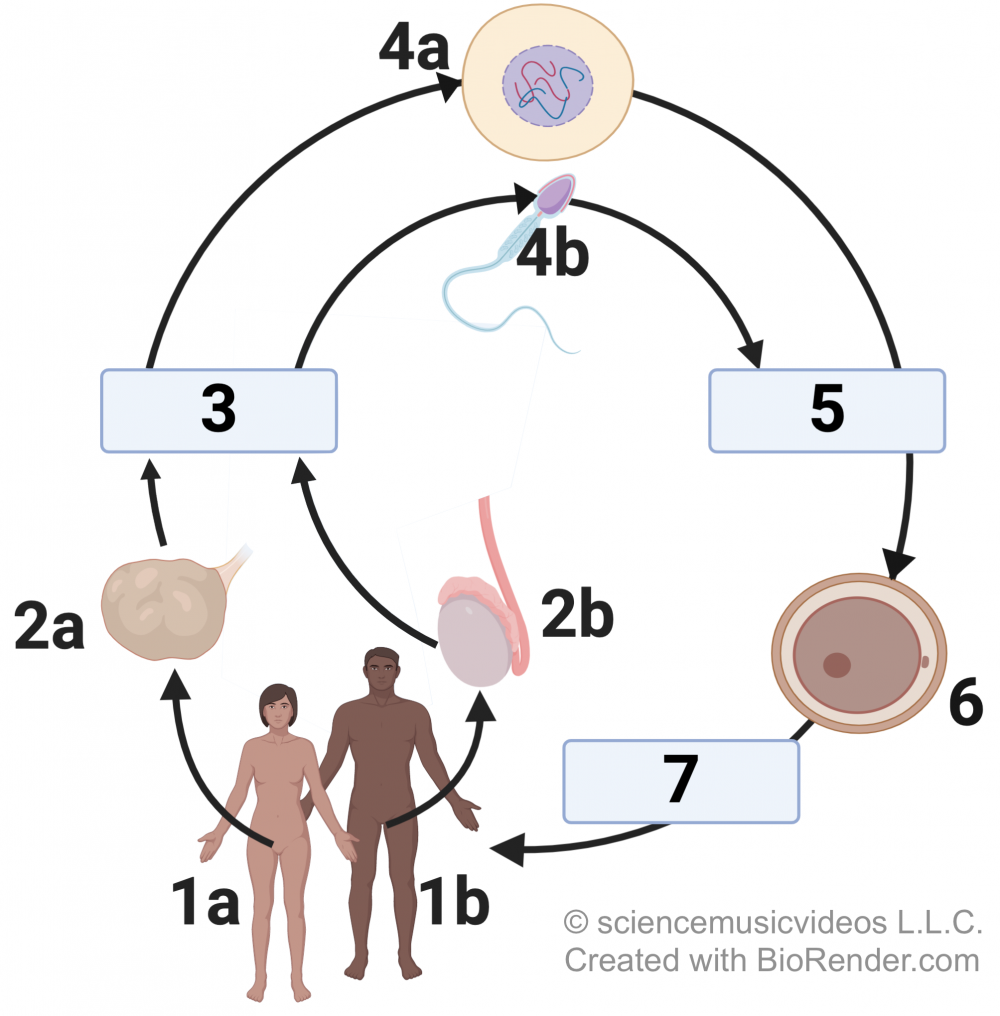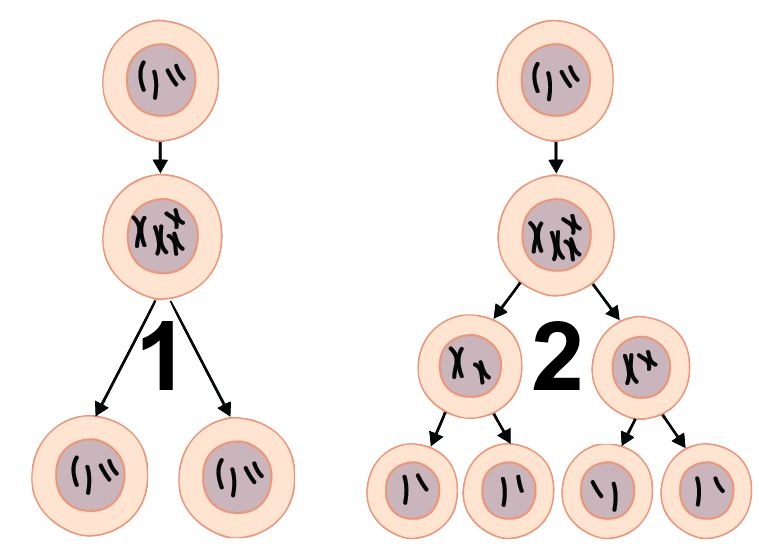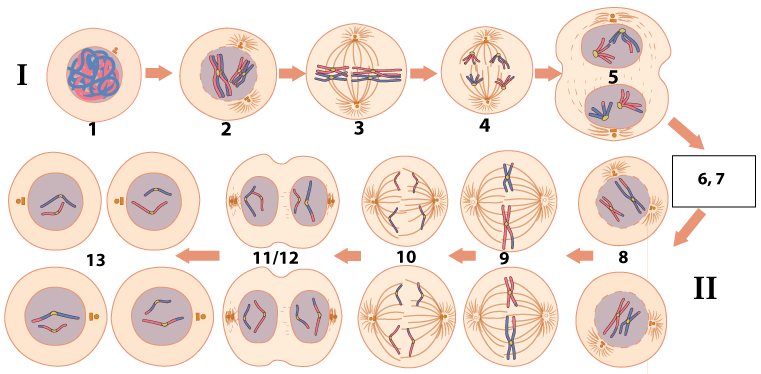Contents
Essential Links
- The College Board’s AP Bio Course and Exam Description.
- My Condensed Version of the Course and Exam Description: takes the objectives, Enduring understandings, and key ideas of the 230-page CED and renders it into 40 pages.
- My AP Exam Review Outline: Takes the Course and Exam description and renders it into student (and teacher) friendly language.
- 2023-24 AP Bio Scope and Sequence Calendar: A spreadsheet that lays out the entire course.
A note about course sequencing
At the top of the Unit 4 Teacher’s Guide, I explain why I suggest teaching Unit 6 (Gene Expression) before teaching Unit 5 (Heredity). If you want to read that, please follow this link.
Meiosis and Chromosomal Inheritance
A note about the sequence
As the College Board suggests, I start with Meiosis (Topics 5.1 and 5.2). After that, however, I suggest you jump to Topic 5.6 (Chromosomal Inheritance). That’s because Topic 5.6 is all about the consequences of meiosis, and it makes much more sense to teach those issues with meiosis, rather than waiting until you’ve covered the next topics (Mendelian and post-Mendelian genetics).
Stitching that all together, here are the College Board’s learning objectives for this unit, reframed in a student and teacher-friendly format.
College Board Learning Objectives for Meiosis
- TOPIC 5.1: Meiosis
- Explain how meiosis transmits genetic material from one generation to the next.
- Compare and contrast diploid and haploid cells, and explain how these terms connect to somatic cells and germ cells.
- Compare and contrast mitosis and meiosis (the types of daughter cells, the number of cell divisions)
- Topics 5.2 and 5.6: Meiosis and Chromosomal Diversity
- Explain how meiosis generates genetic diversity.
- Define “homologous” chromosomes (their origin, and their relationship in terms of genetic information) and explain what happens to homologous pairs during meiosis (independent assortment).
- Explain what crossing over is, and how it generates genetic diversity.
- Explain fertilization (in terms of haploid and diploid chromosome numbers), as well as fertilization’s contribution to genetic diversity.
- Compare meiosis 1 and meiosis 2, and explain what happens during each process.
- Connect the events of meiosis and fertilization to how sexual reproduction creates variation.
- Explain how certain aspects of human genetic variation (Down’s syndrome, etc.) can be explained by chromosomal changes resulting from meiosis (nondisjunction).
Meiosis and Chromosomal Variation tutorials on Learn-Biology.com
If you have your students complete our module about Meiosis on Learn-Biology.com, you can ensure that your students will master all of these objectives. Your students can use this Meiosis Student Learning Guide to guide them through the materials. Note that you can also use this student learning guide as a review sheet and for checking for understanding.
Here’s an overview of what’s in the tutorials.
1. Meiosis: Basic Concepts
This tutorial will teach your students the difference between haploid and diploid cells, and the meaning of the term homologous in the context of meiosis and chromosomes.
2. Meiosis 1 v. Meiosis 2
In this tutorial, your students will come to understand how meiosis, fertilization, and mitosis fit into the life cycle of sexually reproducing organisms, like us. This is captured in the diagram below.

Students will also learn to distinguish between meiosis 1 and meiosis 2 and to be able to compare and contrast mitosis and meiosis, as shown in this diagram.

3. How Meiosis Creates Variation
Our third tutorial focuses on the two key processes by which meiosis creates variation: independent assortment of chromosomes, and crossing over, which creates newly recombinant chromosomes in every generation.
4. Topics 5.1 – 5.2, Part 4: Meiosis, Step by Step
By the end of tutorial four, your students will be able to talk, write and think their way through this diagram, applying all the relevant meiosis-related concepts (haploid, diploid, crossing-over, and independent assortment)

5. Topic 5.6, Part 1: Sex Determination
In this tutorial, we cover the chromosomal basis of sex determination in mammals (the XX-XY system), as well as temperature-dependent sex determination in certain reptile clades, the ZZ/ZW system in birds, and haplodiploidy in bees and ants.
6. Topic 5.6, Part 2: Part 2: Nondisjunction and Human Chromosomal Variation
Tutorial 6 looks at nondisjunction and its consequences: Down Syndrome, Klinefelter Syndrome, XYY, and Turner Syndrome.
7. Topics 5.1, 5.2. 5.6 Flashcards and Multiple Choice Speed Trial
It also includes a cumulative set of flashcards about meiosis and related topics and a Multiple Choice Speed challenge.
Other resources:
My Meiosis Song can help you teach a surprising amount of the material above. Here’s how it starts:
The sperm cells or egg cells performing the feat,
Of moving genes forward in eukaryotes like orchids and bees,
There’s just a few cells that have this hobby,
I’m talking ’bout germ cells in testes and ovaries.
- You inherit half of your genes from your mother and half from your father. Try to describe how you think that might work. Which half?
- If you have one, think of your sibling. If you don’t, think of any pair of siblings that you know. How genetically similar are siblings?
- Humans, like all sexually reproducing beings, expend a lot of energy trying to find mates and pass on their genes. Why do most multicellular eukaryotes reproduce sexually, instead of just cloning themselves?
For a group activity, there’s a Meiosis POGIL, but it’s not in the AP set of POGILS: it’s in the high school set. You can buy POGILS from Flinn Scientific. Note that this is one of a few POGILs from the high school set that I use, so you have to decide if it’s worth the investment (the AP Bio ones definitely are).
In terms of labs, the one that’s recommended by the College Board is the Sordaria lab. (the link goes to the College Board’s AP Bio lab manual: when you get there, search for “sordaria”). I have not done this lab for the last few years, and it seems to be receding from the curriculum. But if you’re up for it, not that the underlying biology of what happens during fungal spore formation, can be fairly tricky and is often misunderstood. Please look at this page on my website for an explanation.
Depending on how comfortable you are working with fungi, you can breed the various strains together yourself, or you can buy pre-inoculated plates from companies like Carolina or Flinn. An even easier route is to just buy Sordaria cards, which are sold by Flinn.
Genetics: Topics 5.3 – 5.5 (Two Weeks)
Teaching Genetics
College Board Learning Objectives for Genetics
Here’s a link to the College Board’s learning objectives for all of Unit 5.
Here’s a list of objectives that are more student (and teacher) friendly.
- Topic 5.3: Mendelian Genetics
- Explain Mendel’s laws of segregation and independent assortment, and connect them to what happens during meiosis.
- Explain relevant rules of probability that apply to genetics. The rule of multiplication is the most important of these.
- Be able to solve genetics problems involving
- monohybrid and dihybrid crosses with autosomal genes;
- blood type (A, B, O system). Note that this while blood type isn’t in the College Board’s standards, you can use it to teach about inheritance patterns with multiple alleles.
- Topic 5.4: Post-Mendelian Genetics
- Explain the chromosomal basis of linkage and recombination. When given data about linkage, be able to determine the distance (in map units) between linked alleles.
- Explain the inheritance patterns of sex-linked genes, and be able to solve genetics problems involving sex linkage.
- Explain non-XY sex determination systems, such as the ZZ/ZW system in birds, haplodiploidy in bees, and temperature-dependent sex determination in certain reptilian clades.
- Define polygenic traits, and describe why these usually have a bell-curve-shaped distribution pattern.
- Explain non-nuclear inheritance (via mitochondria, chloroplasts, etc.)
- Topic 5.5: Environmental Effects on Phenotype
- Explain how the interaction between genotype and environment is a major determinant of phenotype.
Genetics tutorials on Learn-Biology.com
Learn-biology.com organizes online learning about genetics into six tutorials, supported by this student learning guide.
Topics 5.3 – 5.5, Part 1: Mendelian Genetics and Punnett Squares
Using the example of sickle cell anemia, this introductory tutorial will teach basic genetics vocabulary (dominant, recessive, phenotype, genotype, etc). It also walks your students through how to solve genetics problems using Punnett squares.
Topics 5.3 – 5.5, Part 2: Solving ABO Blood Type inheritance problems
In this tutorial, I introduce the idea of codominance and multiple alleles. This topic is not explicitly in the standards, but how can you not teach about blood type?
Topics 5.3 – 5.5, Part 3: Sex-linked alleles, and a few other human genetic conditions to know.
This tutorial covers
- Sex-linkage in humans, focusing on hemophilia.
- Other sex-linked conditions like Red-Green Colorblindness, Duchenne’s Muscular Dystrophy, and white eye color in fruit flies.
- How to use Punnett Squares to solve genetics problems involving sex linkage.
- Sex-linked alleles in birds
- A brief survey of six genetic conditions that AP Bio students should be familiar with: sickle cell anemia, cystic fibrosis, hemophilia (and other sex-linked conditions), Huntington’s disease, and achondroplasia.
Topics 5.3 – 5.5, Part 4: Dihybrid Crosses
After doing this tutorial, your students will know how to set up and solve dihybrid crosses.
Topics 5.3 – 5.5, Part 5: Linkage and Recombination
Linked genes and determining recombination frequencies. Along the way, your student will get a deep understanding of how linkage is different from independent assortment.
Topics 5.3 – 5.5, Part 6: How to do the χ2 (Chi Squared) Test
A step-by-step walkthrough of everything your students need to understand in order to do a Chi square analysis of results from genetic crosses.
Topics 5.3 – 5.5, Part 7: Mitochondrial Inheritance, Incomplete Dominance, and Genotype-Environment Interaction
All of the topics above.
Teaching Genetics in the Classroom
There are a lot of breeding simulations, but I don’t use them. The way to get to mastery of genetics is for students to solve LOTS of genetics problems, and that’s my main focus.
As students solve these problems, I encourage them to use these six steps for solving genetics problems (which are modeled in the tutorials).
- Write the genotypes of the parents.
- Draw a Punnett square.
- Put the possible alleles of the gametes on the top and side of the square.
- Bring the alleles of possible gametes together.
- Show the genotype ratio.
- Show the phenotype ratio.
As students get better at solving problems, they can back off on some of these steps (and some would be ridiculously redundant and time-consuming in certain situations, like dihybrid crosses).
Here’s what I use.
- Here’s a set of beginning-level genetics problem sets that you can use to help your students master the material in the first four tutorials. Note that the last pages have all the solutions (I find that giving out the solutions makes instruction much easier and more successful). Keep in mind that my students did not take a 9th-grade biology course, so these might be too easy for your students.
- For more advanced problems, I go to my textbook…Campbell, Biology in Focus. While I don’t use the text (because I use Learn-Biology.com, which I hope is true of you as well!), I do use the problem sets for Chapter 11 and Chapter 12. The textbook provides answers in the appendix. I spend a fair amount of time both working on these problems in the classroom and having my students work on them (usually in groups).
For teaching χ2, I use this Introduction to Chi-Square slideshow and this handout. The activity culminates in a Chi-square M&Ms lab (so be sure to buy your M&Ms first).
HHMI has a resource that pulls together basic genetics, pedigree analysis, and Chi-Square in relationship to Sickle Cell anemia. Here’s a link to the introductory video, and here’s a link to their worksheet. This link goes to their teacher’s guide.
Both Flinn and Carolina sell simulated blood typing labs in which students have to determine the blood type of four people of unknown blood types by using simulated anti-A, anti-B, and anti-Rh sera and artificial blood. I make this as inductive as possible by using this handout.
I also like to do a Corn Cob Genetics Lab. You have to buy the corn cobs, and the cost of that can be pretty steep (about $150 from Carolina). But the cobs will last for a few years (and longer if you don’t unwrap them). Once you get the cob, all the prep that you have to do is to remove the labels and replace them with letters (A, B, C, and D) so that each cross is coded (and so that only you know the code). Here’s a handout for an open-ended, investigative lab that’s also a lot of fun, and provides a great opportunity for students to practice dihybrid crosses and Chi-square.
For a review of pedigree analysis, I use this worksheet.
Resources for Unit 5 Review
A cumulative review of Unit 5 is available at Unit 5 Cumulative Objectives, Flashcards, and Quizzes
In addition, use the College Board’s resources on AP Classroom, particularly their progress check questions.
Links
